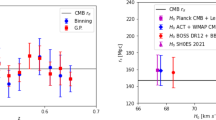Abstract
We have succeeded in establishing a cosmological model with a non-minimally coupled scalar field φ that can account not only for the spatial periodicity or the picket-fence structure exhibited by the galaxy N-z relation of the 2dF survey but also for the spatial power spectrum of the cosmic microwave background radiation (CMB) temperature anisotropy observed by the WMAP satellite. The Hubble diagram of our model also compares well with the observation of Type Ia supernovae. The scalar field of our model universe starts from an extremely small value at around the nucleosynthesis epoch, remains in that state for sufficiently long periods, allowing sufficient time for the CMB temperature anisotropy to form, and then starts to grow in magnitude at the redshift z of ∼1, followed by a damping oscillation which is required to reproduce the observed picket-fence structure of the N-z relation. To realize such behavior of the scalar field, we have found it necessary to introduce a new form of potential V(φ)∝ φ 2exp (−q φ 2), with q being a constant. Through this parameter q, we can control the epoch at which the scalar field starts growing.
Similar content being viewed by others
References
Adelman-McCarthy, J. et al.: Astrophys. J. Suppl. Ser. (2007, in press)
Astier, P., et al.: Astron. Astrophys. 447, 31 (2006)
Baccigalupi, C., Matarrese, S., Perrotta, F.: Phys. Rev. D 62, 123510 (2000)
Berti, E., Buonanno, A., Will, C.M.: Class. Quantum Gravity 22, 943 (2005)
Bertotti, B., Iess, L., Tortora, P.: Nature 425, 374 (2003)
Broadhurst, T.J., Ellis, R.S., Koo, D.C., Szalay, A.S.: Nature 343, 726 (1990)
Caldwell, R.R.: Phys. Lett. B 545, 23 (2002)
Caldwell, R.R., Kamionkowski, M., Weinberg, N.N.: Phys. Rev. Lett. 91, 071301 (2003)
Colless, M.M., et al.: Mon. Not. R. Astron. Soc. 328, 1039 (2001)
Freedman, W.L., et al.: Astrophys. J. 553, 47 (2001)
Fukuyama, T., Hatakeyama, M., Miyoshi, M., Morikawa, M., Nakamichi, A.: Int. J. Mod. Phys. D 6, 69 (1997)
Gardner, J.P.: Publ. Astron. Soc. Pac. 110, 291 (1998)
Hansen, C.J., Kawaler, S.D.: Stellar Interiors: Physical Principles, Structure, and Evolution. Springer, New York (1994)
Hill, C.T., Steinhardt, P.J., Turner, M.S.: Phys. Lett. B 252, 343 (1990)
Hill, C.T., Steinhardt, P.J., Turner, M.S.: Astrophys. J. Lett. 366, L57 (1991)
Hinshaw, G., et al.: Astrophys. J. Suppl. Ser. 170, 288 (2007)
Hirano, K., Kawabata, K., Komiya, Z., Bunya, H.: In: Suzuki, H., Yokoyama, J., Suto, Y., Sato, K. (eds.) Inflating Horizons of Particle Astrophysics and Cosmology, p. 219. Universal Academy Press, Tokyo (2006)
Kashino, Y., Kawabata, K.: In: Sato, K. (ed.) Evolution of the Universe and its Observational Quest, p. 461. Universal Academy Press, Tokyo (1994)
Kawabata, K., Matsushita, E., Komiya, Z., Hirano, K., Yamamoto, N.: In: Proc. IAU 8-th Asian-Pacific reg. meeting, vol. II, p. 253 (2002)
Komiya, Z., Kawabata, K., Hirano, K., Bunya, H., Yamamoto, N.: J. Korean Astron. Soc. 38, 157 (2005)
Komiya, Z., Kawabata, K., Hirano, K., Bunya, H., Yamamoto, N.: Astron. Astrophys. 449, 903 (2006)
Lazkoz, R., Nesseris, S., Perivolaropoulos, L.: J. Cosmol. Astropart. Phys. 11, 010 (2005)
Lewis, A., Bridle, S.: Phys. Rev. D 66, 103511 (2002)
Lewis, A., Challinor, A., Lasenby, A.: Astrophys. J. 538, 473 (2000)
Ma, C.P., Bertschinger, E.: Astrophys. J. 455, 7 (1995)
Mather, J.C., Fixsen, D.J., Shafer, R.A., Mosier, C., Wilkinson, D.T.: Astrophys. J. 512, 511 (1999)
Morikawa, M.: Astrophys. J. Lett. 362, L37 (1990)
Morikawa, M.: Astrophys. J. 369, 20 (1991)
Nagata, R., Chiba, T., Sugiyama, N.: Phys. Rev. D 69, 083512 (2004)
Naselsky, P.I., Novikov, D.I., Novikov, I.D.: The Physics of the Cosmic Microwave Background. Cambridge University Press, Cambridge (2006) 255 pp
Norberg, P., et al.: Mon. Not. R. Astron. Soc. 336, 907 (2002)
Peebles, P.J.E., Ratra, B.: Astrophys. J. 325, L17 (1988)
Perlmutter, S., et al.: Astrophys. J. 517, 565 (1999)
Perrotta, F., Baccigalupi, C.: Phys. Rev. D 59, 123508 (1999)
Perrotta, F., Baccigalupi, C.: Phys. Rev. D 65, 123505 (2002)
Quevedo, H., Salgado, M., Sudarsky, D.: Astrophys. J. 488, 14 (1997)
Ratra, B., Peebles, P.J.E.: Phys. Rev. D 37, 3406 (1988)
Rich, J.: Fundamentals of Cosmology. Springer, Berlin (2001) 302 pp
Riess, A.G., et al.: Astron. J. 116, 1009 (1998)
Riess, A.G., et al.: Astrophys. J. 607, 665 (2004)
Riess, A.G., et al.: Astrophys. J. 659, 98 (2007)
Salgado, M., Sudarsky, D., Quevedo, H.: Phys. Rev. D 53, 6771 (1996)
Schechter, P.: Astrophys. J. 203, 297 (1976)
Seljak, U., Zaldarriaga, M.: Astrophys. J. 469, 437 (1996)
Spergel, D.N., et al.: Astrophys. J. Suppl. Ser. 170, 377 (2007)
Tegmark, M., et al.: Astrophys. J. 606, 702 (2004)
Yoshida, N., et al.: Mon. Not. R. Astron. Soc. 325, 803 (2001)
Yoshii, Y., Takahara, F.: Astrophys. J. 326, 1 (1988)
Author information
Authors and Affiliations
Corresponding author
Rights and permissions
About this article
Cite this article
Hirano, K., Kawabata, K. & Komiya, Z. Spatial periodicity of galaxy number counts, CMB anisotropy, and SNIa Hubble diagram based on the universe accompanied by a non-minimally coupled scalar field. Astrophys Space Sci 315, 53–72 (2008). https://doi.org/10.1007/s10509-008-9794-7
Received:
Accepted:
Published:
Issue Date:
DOI: https://doi.org/10.1007/s10509-008-9794-7




